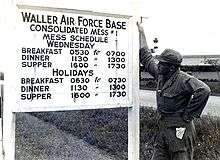Waller Air Force Base
Waller Air Force Base | |
|---|---|
| Part of Sixth Air Force | |
| Located in Trinidad | |
 Waller AFB | |
| Coordinates | 10°36′48.87″N 061°12′48.30″W / 10.6135750°N 61.2134167°W |
| Type | Military airfield |
| Site information | |
| Controlled by | United States Air Force |
| Site history | |
| Built | 1941 |
| In use | 1941-1949 |
Waller Air Force Base is a former United States Army Air Forces World War II air base located in northeastern Trinidad. It is located about 5 miles (8 km) southwest of Valencia south of the Churchill-Roosevelt Highway.
History
The American rights to the airfield were obtained via the Destroyers for Bases Agreement in September 1940 when the United States transferred fifty destroyers to Great Britain in exchange for Army and Navy base rights on British possessions in the Americas.
In 1941, Trinidad was alarmed by a large number of Nazi U-Boats prowling of its coastline, intent on disrupting British shipping in the Caribbean Sea, and using the Vichy French controlled island of Martinique as a possible supply facility. Although the first United States Army personnel arrived on Trinidad on 24 April 1941, it was only with the United States' entry into the war in early 1942 that Allied planners decided to counter the Nazi threat by establishing major air and naval facilities on Trinidad.
Waller Army Airfield was activated on 1 September 1941 with the assignment of the 92d Service Group. The unit's mission was to establish a flying facility within the United States Army Fort Read post. The unit consisted of the group's Headquarters, and the 92d Air Base and 309th Material Squadrons. The group was assigned to the Caribbean Air Force.

Waller Field was named after United States Army Air Force Major Alfred J. Waller. Major Waller was a distinguished World War I combat pilot and was killed in the crash of Consolidated PB-2A, 35-50, on 11 December 1937 at Langley Field, Virginia. The airfield was intended to have four runways, but the two southern ones were canceled due to the nature of the ground.
Waller was built to be the premier US combat airbase in Trinidad, but events overtook the plan. The South Atlantic Air Route to Europe quickly developed and became the most often used method of getting aircraft to the African and European theaters of war. Air Transport Command flew aircraft to Waller from South Florida airfields, then from Waller, aircraft were flown to Belem Airfield, Brazil, then across the South Atlantic Ocean to Freetown Airport, Sierra Leone and then to North Africa or England. Airfield congestion at Waller became so acute that the combat aircraft, the bombers actually confronting the U-Boats had to be moved out to Edinburgh (Carlsen) Airfield when it was completed.
With the establishment of United States bases on Trinidad and other Caribbean islands, the Nazi menace was eliminated by the action of numerous air and naval patrols. In 1943, President Franklin Roosevelt visited Waller Field on his way to the Casablanca Conference in North Africa.
Major units assigned
|
|
*Reassigned from Fifteenth Air Force in Italy and used B-24 Liberator aircraft as transports moving personnel from Mediterranean Theater to the United States
In addition to the combat and transport flying units, Waller Field was also used as an aircraft maintenance and supply facility by the 24th Air Depot (Air Technical Service Command) which was deployed from Kelly Field, Texas on 20 January 1942. It was also used as a long-range reconnaissance base by several photo-recon squadrons.
Postwar use
With the end of World War II Waller Airfield was reduced in scope to a skeleton staff. It was redesignated Waller Air Force Base on 26 March 1948, by the Department of the Air Force General Order Number 10.
Its primary use was by Military Air Transport Service (MATS) as a transit facility under the 24th Composite Wing based at Borinquen AFB, Puerto Rico and by the MATS 6th Weather Squadron (Regional), which provided meteorological reports for aviation in the South Caribbean as well as tropical storm and hurricane reporting. President Harry S. Truman stopped at Waller Field on 31 August 1947 on his way to Brazil during a South American visit.
Waller AFB was closed on 28 May 1949 due to budgetary cutbacks and MATS operations were shifted to bases in the Panama Canal Zone.
After the base's closure, it became the informal home of various types of racing (using former airstrips) for over 40 years. Today construction progresses on the former airfield site for a new multimillion-dollar University of Trinidad and Tobago campus complex, several housing developments and other projects.
References
![]() This article incorporates public domain material from websites or documents of the Air Force Historical Research Agency.
This article incorporates public domain material from websites or documents of the Air Force Historical Research Agency.
- Maurer, Maurer (1983). Air Force Combat Units Of World War II. Maxwell AFB, Alabama: Office of Air Force History. ISBN 0-89201-092-4.
- Maurer, Maurer, ed. (1982) [1969]. Combat Squadrons of the Air Force, World War II (PDF) (reprint ed.). Washington, DC: Office of Air Force History. ISBN 0-405-12194-6. LCCN 70605402. OCLC 72556.
- USAFHRA Microfilm 01023751. History of Waller Air Force Base (1942-1950)
- Truman Library photos of President Truman at Waller Field
External links
| ||||||||||||||||||||||||||||||||||||||||||||||||||||||||||||
| ||||||||||||||||||||||
.jpg)